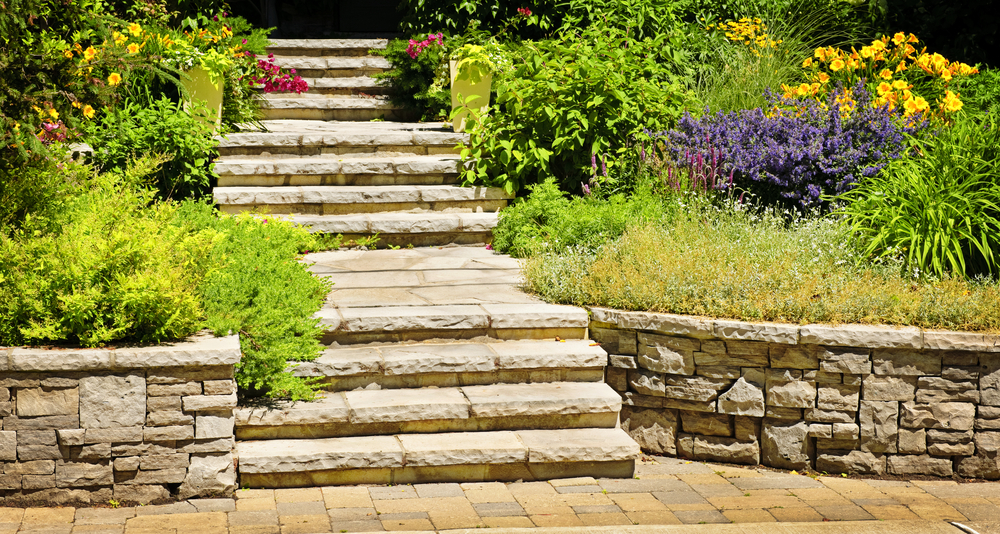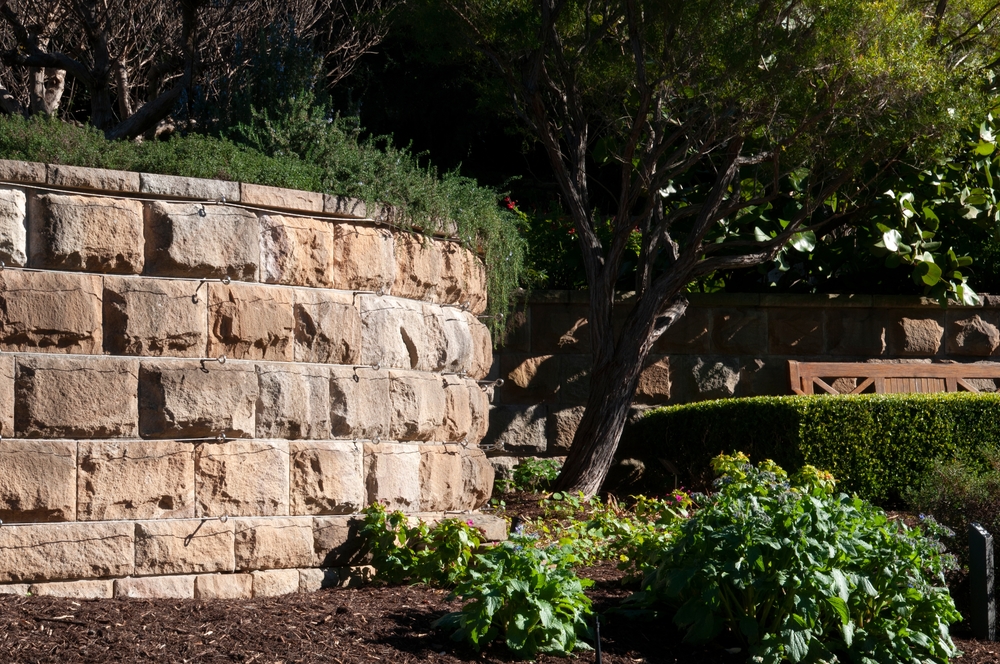Retaining walls are more than just landscape features; they're essential for protecting properties from erosion and preserving soil stability, especially in sloped or elevated areas like Drouin, Victoria. These structures create functional, levelled spaces while reinforcing embankments and reducing runoff damage. Whether you're dealing with an uneven garden or looking to prevent landslides on your property, retaining walls provide a smart, structural solution that blends function with visual appeal. This guide explores how retaining walls work, what materials to consider, and how proper design and maintenance can make all the difference.

Retaining walls play a vital role in ensuring soil stability and protecting landscapes from erosion, especially in the Drouin area. But what exactly are retaining walls, and how do they fulfill their purpose?
Retaining walls are structures designed to hold back and support soil on one side while providing a clear boundary or transition on the other side. They are commonly used in areas like Drouin, where there is a significant difference in elevation between two adjacent surfaces. By preventing soil movement and erosion, these walls help maintain the integrity of landscapes and prevent potentially damaging consequences unique to the Drouin region.
There are various types of retaining walls, each suited for different scenarios based on factors such as slope angle, soil type, and budget constraints. Gravity walls rely on their weight to resist soil pressure, while reinforced soil retaining walls utilise layers of geosynthetic reinforcement to enhance strength. Cantilevered walls use structural elements like footing and stem to provide stability, while counterfort or buttress walls incorporate additional supports at regular intervals for added peace of mind in the challenging terrain of Drouin.
Retaining walls provide numerous advantages when it comes to landscape protection and soil stability. Let's explore some of the key benefits:
Imagine a house situated on a hillside where a series of beautifully crafted retaining walls create stunning terraced garden beds, which once served no purpose due to slope. Not only does this transform the property into an appealing visual spectacle, but it also increases its market value due to the added functionality and optimised land use.
Retaining walls offer undeniable advantages when it comes to preserving soil stability and safeguarding landscapes from erosion while maximising land utilisation and aesthetic appeal. However, it's essential to consult professionals who can assess your specific needs and provide expert guidance on material selection, design considerations, and construction methods for the most effective retention solution.
When it comes to constructing retaining walls, a variety of materials can be used based on factors such as cost, aesthetics, and functionality. Let's explore some common materials that are often employed in the construction of retaining walls.
One popular choice is concrete, which provides the durability and strength necessary for supporting the earth and resisting erosion. Concrete blocks or poured concrete walls offer versatility in terms of shape and size, allowing for customisation based on specific requirements. The smooth surface of concrete can also be finished or veneered with other materials to enhance its appearance.
For an environmentally-friendly option, timber is a commonly used material due to its natural appeal and ease of installation. Pressure-treated timber is treated to resist rot and insect damage, making it suitable for long-term use. Timber retaining walls can blend seamlessly with the landscape, especially in natural settings or areas with existing wooden structures.
Another durable material is stone, offering both aesthetic appeal and structural integrity. Natural stone, such as granite or limestone, provides a classic and timeless look, while manufactured stone veneers offer a more affordable alternative without compromising on style. Stone retaining walls are often chosen for their beauty and ability to complement the surrounding environment.
Brick retaining walls add a touch of elegance and charm to any landscape. With countless patterns and designs available, bricks allow for creative expression while providing stability against erosion. The versatility of brick allows it to be easily combined with other materials like concrete or steel reinforcements to increase its structural strength.
In addition to these primary materials, geo-synthetics are often used as reinforcement in retaining wall construction. These synthetic materials, such as geotextiles or geogrids, help distribute the weight and forces exerted by the retained soil behind the wall. They also aid in preventing soil erosion by promoting water drainage while maintaining soil stability.
Each material offers unique benefits and considerations that should be evaluated based on factors such as budget, desired aesthetics, and the specific requirements of the project. It is important to consult with a professional contractor or engineer to determine the most suitable material for your retaining wall based on these factors.
Erosion can wreak havoc on landscapes, leading to soil instability, loss of vegetation, and even property damage. Retaining walls is an effective solution for mitigating erosion and maintaining soil stability in various settings. Whether in residential gardens, commercial properties, or infrastructure projects, retaining walls serve as a protective barrier against erosive forces.
One key mechanism by which retaining walls prevent erosion is through slope stabilisation. When natural slopes are prone to erosion, retaining walls provide support and hold back the soil. With their structural integrity and reinforcement systems, they counteract gravitational forces, preventing soil collapse and minimising erosion caused by surface runoff or excessive moisture.
Moreover, retaining walls work by controlling water flow. By diverting water away from vulnerable areas or creating terraced sections within the landscape, they help to manage stormwater runoff effectively. This controlled drainage reduces the velocity of water flow, allowing it to infiltrate slowly into the ground rather than causing erosion by rushing over unprotected surfaces.
For instance, consider a hilly vineyard where heavy rainfall could wash away fertile topsoil crucial for grape cultivation. Constructing terraced retaining walls can create level planting areas that prevent soil erosion while facilitating irrigation and root access for vines. This demonstrates how retaining walls serve multiple purposes beyond erosion prevention alone.
Additionally, retaining walls stabilise embankments along roadways and railways, ensuring safety for vehicles and preventing potential landslides. By reinforcing the embankments with retaining walls, the stability of the soil is enhanced, reducing the risk of erosion and erosion-induced hazards.
Some may argue that retaining walls can disrupt natural drainage patterns, leading to water accumulation and potential damage. While this concern is valid, proper design and construction techniques can address this issue by incorporating weep holes or other drainage systems into the wall. It's crucial to work with a knowledgeable professional who can ensure that the retaining wall is appropriately constructed to mitigate any potential negative effects.
With a clear understanding of how retaining walls act as a measure against erosion, let's now delve into a detailed breakdown of the erosion prevention processes employed by these structures.
Erosion, caused by wind, water, and gravity, can damage landscapes and weaken soil stability. Retaining walls help prevent this by acting as structural barriers that hold back soil and redirect water flow.
Retaining walls reduce erosion by supporting sloped areas and slowing the movement of water during heavy rainfall or over-irrigation.
Picture this: A sloped garden without any retaining walls. With each downpour, soil gets washed away, forming gullies and destabilising the area. But with retaining walls, the pressure from the soil is redistributed, helping keep everything in place.
Key Elements of Erosion Prevention and How Retaining Walls Help
Now that we’ve explored how retaining walls help prevent erosion, let’s look at how they can also enhance your landscape’s appearance and functionality.

Retaining walls not only serve a practical purpose in preventing erosion but also provide an opportunity to enhance the aesthetics and functionality of outdoor spaces. These walls can transform an ordinary landscape into a visually striking and multi-tiered oasis, creating endless possibilities for creative landscaping designs.
One way retaining walls enhance landscapes is by creating level terraces or distinct raised beds behind the wall. These platforms offer ideal spaces for gardening, allowing homeowners to cultivate a variety of plants, flowers, and even small trees. As a result, the retaining walls preserve vegetation while adding texture and depth to the overall landscape.
Imagine walking through a garden where layers of retaining walls form beautiful terraced gardens at different heights adorned with colourful flowers and lush greenery. The multiple levels created by these walls don't just add visual appeal; they also provide space for various outdoor activities such as seating areas, pathways, or even water features like cascading waterfalls.
In addition to their aesthetic value and functional potential, retaining walls can be constructed using a variety of materials such as natural stone, wood, concrete blocks, or even recycled materials like railway sleepers. This array of options lends itself to creative freedom when designing retaining walls that complement the existing landscape style and blend harmoniously with the surroundings.
For instance, if your backyard has a rustic charm, you could opt for natural stone retaining walls that accentuate its organic beauty. On the other hand, concrete block walls might be more suitable for contemporary landscapes due to their clean lines and versatility in creating different shapes.
When it comes to creating durable and effective retaining walls in Drouin, like the ones offered by JBS Walls, a systematic approach is essential. Here are the key steps involved:
In conclusion, designing and installing retaining walls in Drouin involves comprehensive planning, expert execution, and ongoing maintenance. By following these steps and seeking professional assistance when needed, you can create resilient and visually appealing retaining walls that effectively combat erosion and ensure soil stability.
Regular maintenance is crucial for retaining walls to effectively prevent erosion. This includes inspecting the walls for any signs of damage or wear, such as cracking or shifting and repairing them promptly. Additionally, it is important to ensure proper drainage behind the wall to prevent water buildup, which can weaken the structure. According to a study by the National Concrete Masonry Association, regular maintenance can extend the lifespan of a retaining wall by up to 40%.
Retaining walls are highly effective at preventing erosion in different types of terrain and climates. Their sturdy construction holds back soil, preventing it from washing away during heavy rainfall or slope instability. In fact, a study conducted by the National Centre for Asphalt Technology found that retaining walls reduced erosion by up to 80% in areas with steep slopes and heavy rainfall. Additionally, their versatility allows for adaptation to various terrains, making them a reliable solution for erosion control in diverse environments.
JBS Retaining Walls plays a vital role in Drouin, Victoria, by offering effective solutions for erosion prevention and soil stability. Their expertise in materials and construction ensures durable and aesthetically pleasing retaining walls that safeguard landscapes. These walls not only prevent erosion but also maximise land utilisation, enhance property aesthetics, and increase overall property value. JBS's professional approach, including site assessment, design, and maintenance, ensures long-lasting protection against erosion while adapting to diverse terrains and climates. Whether for a small garden or a larger property, JBS Retaining Walls projects excel in providing comprehensive solutions for erosion control and landscape enhancement.